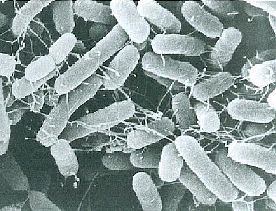Tokyo Food Safety Information Center » Good things to know » The microorganisms which cause food poisoning » Salmonella
Salmonella
Characteristics

A vast variety of salmonella species are found in the digestive tracts of animals such as chickens, pigs, and cows, as well as in rivers and sewers, with over 2,500 serotypes known.
It was once believed that a large number of salmonella bacteria were required to cause illness, but it has recently been found that even small amounts of salmonella can cause infection and illness. Salmonella causes infection through intake of contaminated food and is characterized by the high fevers it causes.
Which foods can cause salmonella infection?
The following foods can easily cause salmonella infection when made using meat and eggs contaminated with salmonella.
Eggs (including egg products), beef liver sashimi, cooked meats (especially chicken), eel, and turtle, and etc.
In addition, contamination of food may also occur via rats and pets.
What are the symptoms of salmonella infection?
The primary symptoms of infection are stomach pain, diarrhea, vomiting, and fever (38-40° C) after an incubation period of 6 to 72 hours.
What are the key points to preventing salmonella infection?
- Always wash and disinfect hands and cookware whenever they come in contact with meat and eggs (preventing secondary contamination).
- Only purchase fresh eggs and store them in a refrigerator after purchase.
- If you choose to eat raw eggs, be sure to consume them before the displayed expiration date.
- Immediately cook and eat eggs after cracking them open. Note that eggs which have been cracked open should never be left to sit for any period of time.
- Keep meat and other goods prone to salmonella at low temperatures.
- When cooking food, ensure that it is heated sufficiently to ensure that heat penetrates to the core of the food.
- Strictly enforce stool tests.
- Take measures to exterminate rats, cockroaches, flies, and other pests.